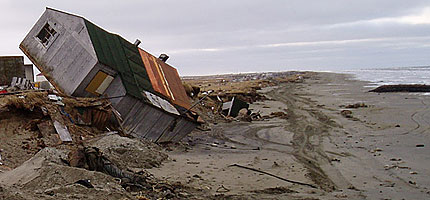© Shishmaref Alaska Erosion & Relocation Coalition
USA: A Battle for Cultural Survival
Faith Galvanizes Indigenous Village into Action amid Dramatic Climate Change
No roads lead to Shishmaref, a traditional Inupiaq village along the Alaskan coast, where residents live on seals, walrus, fish, birds, caribou and moose that they hunt themselves. Villagers, the Inuit people of Alaska's Arctic Northwest and Bering Straits region, date their culture back thousands of years.
Located on an island about three miles long and a quarter mile wide (4.8 x 0.4 km) and home to some 560 people, Shishmaref is washing out to sea. It is among the three most imperiled Alaskan villages endangered by erosion and flooding due to climate change, according to a report by the United States Government Accountability Office. It could be wiped out in less than 10 years, says the United States Army Corps of Engineers, the federal agency responsible for the development and maintenance of water and related environmental resources.
The village leaders are disclosing to residents that they must choose another relocation site for the town, since they learned that the long-chosen site of Tin Creek on the nearby mainland is plagued by degrading permafrost.
"It’s more or less ice and not anchored enough for a town," said Darlene Turner, village leader and president of Shishmaref Lutheran Church, a congregation of the Evangelical Lutheran Church in America (ELCA) Alaska Synod.
"It’s disappointing,” Turner said. “This puts us back at square one."
Dramatic Impact
"The impact of climate change is dramatic in Alaska, and the rest of the United States doesn’t understand that," said Bishop Michael Keys, Alaska Synod.
Shishmaref Lutheran Church dates back to 1930 and is the northernmost ELCA congregation. The congregation's late pastor, Rev. Robert H. Wentzien, had voiced concerns before his death last year about the reduction of water access at the Tin Creek site as well as the long-term impact of any relocation. "I am very concerned, not just about their commerce and industry, but about their entire culture, oral traditions, family traditions and more," he told ELCA Communication Services.
The cost of relocating the village to the mainland is estimated at USD 180 million, while moving residents 120 miles (192 kilometers) south to a designated area in Nome is calculated at roughly half that price.
Traditional Values, Customs
For residents, relocation is a battle for survival as a people as well as a village. The majority oppose moving to cities such as Nome or Anchorage because of the dramatic lifestyle changes, said Stanley Tocktoo, head of the Shishmaref Erosion and Relocation Committee.
"The majority want to stay on the mainland in the area and subsist on the land and sea like we always have," said Tocktoo. "We don't want to be separated. We want to keep intact our traditional values and customs."
The bishop pointed out two other villages in the synod - Wales and Teller - may also face relocation.
"If you just move people to Nome or Anchorage, you’re losing cultural diversity," said Keys. "You need to consider the cultural perspective. Is there a value that this cultural diversity exists? Is the indigenous lifestyle-culture, values and language-valuable?" he remarked.
Shishmaref Lutheran Church, the island's only church, provided parcels of land so that many of those immediately threatened could move to safer ground.
"These are people of deep, deep extraordinary faith and witness," said Keys. "It will allow them to face very, very difficult challenges ahead of them and be a significant part of how they respond."
The Alaska synod is one of the 65 synods of the 4.7-million-member ELCA, which joined the LWF in 1986.
Adapted from the original ELCA Communication Services article

